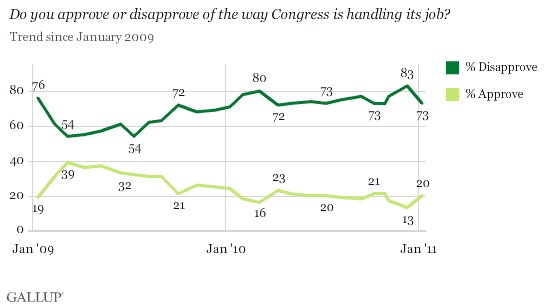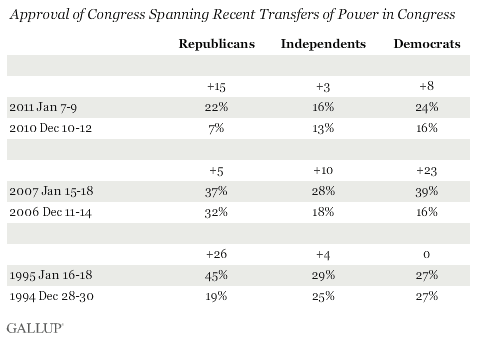PRINCETON, NJ -- Americans' approval of the job Congress is doing rose in early January to 20%, after falling to a record-low 13% in mid-December and registering 17% in November. Support for Congress had been at or near 20% from about May of last year through October.

The poll was conducted Jan. 7-9, the same weekend that Arizona Rep. Gabrielle Giffords was critically wounded by a gunman who reportedly targeted her at a constituent outreach event in Tucson. However, there is no evidence in the day-by-day results that the Saturday shootings had any effect on attitudes about Congress as a whole.
Americans' 13% approval of Congress last month was recorded shortly after President Obama and congressional Republican leaders came to agreement on a plan to extend tax cuts put in place under George W. Bush, but before Congress passed that plan and several other major bills. The record-low rating was mainly the result of a drop in approval among Democrats, who may have either disagreed with the compromise plan or been unhappy about the enhanced role Republicans were playing in the legislative process.
Republicans' approval of Congress is up since December, and the 22% currently approving is the highest in nearly two years. Approval also improved among Democrats, from 16% to 24%. Still, Democrats' approval remains significantly lower than what it was for most of 2010, clearly reflecting those partisans' diminished approval now that Republicans have majority control of the 112th Congress. Independents' approval today is similar to December and to their ratings all of last year.

The partisan changes in congressional approval this month are similar to the patterns seen the last two times party control of Congress changed hands. In January 2007, after a new Democratic majority was sworn in, giving Democrats control for the first time since early 1995, Gallup found approval of Congress more than doubling among Democrats -- from 16% to 39%, while approval among Republicans also rose slightly, from 32% to 37%.
Similarly, in January 1995, after Republicans took power in Congress for the first time in 40 years, approval among Republicans rose from 19% to 45%, while Democratic approval held steady at 27%.

Compared with changes in approval of Congress among Republicans in 1995 and among Democrats in 2007, the recent 15-point increase in Republicans' approval is on the low side, as is their 22% approval rating of the new Congress. This likely reflects that Republicans now control only one chamber of Congress, not two, as Republicans did in 1995 and Democrats did in 2007. Additionally, overall public approval of Congress is restrained given the ongoing problems in the U.S. economy, including a battered housing market and a persistently high unemployment rate.
Survey Methods
Results for this Gallup poll are based on telephone interviews conducted Jan. 7-9, 2011, with a random sample of 1,018 adults, aged 18 and older, living in the continental U.S., selected using random-digit-dial sampling.
For results based on the total sample of national adults, one can say with 95% confidence that the maximum margin of sampling error is ±4 percentage points..
Interviews are conducted with respondents on landline telephones (for respondents with a landline telephone) and cellular phones (for respondents who are cell phone-only). Each sample includes a minimum quota of 200 cell phone-only respondents and 800 landline respondents, with additional minimum quotas among landline respondents for gender within region. Landline respondents are chosen at random within each household on the basis of which member had the most recent birthday.
Samples are weighted by gender, age, race, education, region, and phone lines. Demographic weighting targets are based on the March 2010 Current Population Survey figures for the aged 18 and older non-institutionalized population living in continental U.S. telephone households. All reported margins of sampling error include the computed design effects for weighting and sample design.
In addition to sampling error, question wording and practical difficulties in conducting surveys can introduce error or bias into the findings of public opinion polls.
View methodology, full question results, and trend data.
For more details on Gallup's polling methodology, visit www.gallup.com.
